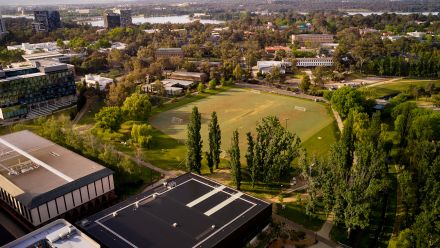The trees that make you sneeze
Did you know Canberra is the allergy capital of Australia? No, we aren't 'pollen' your leg. Gouri Banerji finds out what trees and plants can cause hay fever havoc.
Sniffles, sneezes and scratchy eyes ... hay fever season is coming! So it's a good time to clear the air and learn more about the trees that make you sneeze.
From winter through to summer, many trees produce allergic pollen. Canberra's mix of native and introduced plant species means people with allergies have good reason to feel uneasy for much of the year.
The tree pollen season usually runs from mid-July to October, followed by grass pollen season between October and December. Late winter is dominated mainly by pollen from Cypress and other pines and ash trees, and there are abundant spores produced by fungal growth during wet days.
But what other sources of sniffles should you be alert to and when? Leading pollen expert Professor Simon Haberle from the School of Culture, History and Language at ������ý National University (ANU)- known on social media as -has the lowdown on the usual, and some not-so-usual, suspects.
Naughty needles
The main culprits are typically pine trees, which are wind-pollinated and produce profuse quantities of pollen, Haberle says. "Between August and November in the ACT, 'dust clouds' of pollen can be seen blowing from trees or settling in ponds and pools, leaving a distinctive yellow 'smear' on the water's surface."
The Cypress pine is the first pine to release pollen around the end of July. They are responsible for copious amounts of pollen that can trigger conditions such as winter conjunctivitis, rhinitis and asthma.
There's no shortage of variety when it comes to pollen culprits. After the pines have released their pollen, it's time for the elms, and, soon after, alder, birch and plane trees.
Alder and birch trees are commonly used for landscaping in and around Canberra's gardens, parks and streets. Their pollen is derived from tightly bunched flowers called catkins that release lots of pollen from August to October, Haberle says. Alder tree pollen can cause hay fever and bronchial asthma, as does pollen from plane trees.
Next up, it's the poplars and willows, commonly known as the 'fluff trees' for the white, cotton wool-like fuzz they produce in spring. These trees usually do their thing in October, Haberle says, but the fluff is really seed and not pollen, although there's still a period of pollen for poplars in late September.
While some people suspect the fluff causes hay fever, experts at ANU have .
And if you're thinking "what about wattle", well, while it's earned a bad reputation, it actually doesn't really do so much damage, Haberle confirms. "Since wattle pollen is heavy, it falls quickly to the ground rather than floating in the air."
Weapons of grass destruction
It's not just trees that can have us reaching for the tissues. Various grasses also start flowering in late September and early October.
Just as the warmth of spring hits the air, hay fever sufferers are filled with dread at the thought of stepping outside because out there lies one unassuming but highly potent irritant. From spring to summer, ryegrass wreaks havoc in the ACT and spores are particularly prevalent during strong north-west winds following a run of clear, sunny days.
Native to North Africa, Europe and western Asia, it is grown as a pasture grass and also deliberately planted in recreation areas in the temperate regions of Australia. "Ryegrass often becomes naturalised in agricultural areas, along roadsides and near habitation, but also invades a wide variety of natural habitats," Haberle says. "It's wind-pollinated and releases large quantities of pollen during peak flowering season."
And then there were weeds
As if it wasn't enough to be dealing with an overwhelming bouquet of trees and grasses, certain herbs and weeds also produce allergenic pollen, primarily in late spring to summer. One of those is Lamb's Tongue, or plantain, an abundant lawn weed in temperate regions of Australia, says Haberle. It is wind-pollinated and produces large amounts of pollen between October and February.
Meanwhile, Paterson's Curse is wind- and insect-pollinated and produces large amounts of pollen from September to January. It's a winter annual plant that was brought into Australia, possibly as an accidental contaminate of pasture seed or as an ornamental plant. It's now a dominant broadleaf pasture weed through much of southern Australia and also infests native grasslands, heathlands and woodlands.
There's mower to come
For many hay fever and asthma sufferers, the task of mowing the lawn can be particularly symptom-inducing. But the culprit isn't the grass pollen itself-the more likely perpetrators are Alternaria. These microscopic fungal spores or molds can be found on plant leaves and stems, grasses and within the soil.
Lawn story short, mowing in urban regions and crop harvesting in rural areas can increase the levels of Alternaria spores in the air, Haberle says. They are most prevalent from spring through to late autumn in temperate areas, and particularly during dry, windy conditions following a period of rain.
So, here's some sage advice...
According to Haberle, we're surrounded by new trees that simply can't help spreading their pollen- that's what makes Canberra, the 'allergy capital of Australia', so beautiful.
"One of the reasons that Canberra is such a hot spot for hay fever and asthma is that it's been beautifully landscaped with newly planted trees, which have allergens," he says.
Resources such as the and the can assist people who suffer from hay fever and asthma by providing daily pollen counts and forecasts.
And until we have less-allergenic tree plantations across the region, here's the bottom line for 'hay feverists' everywhere: use antihistamines as needed but more importantly, be aware of everything in your surroundings that may not tickle your fancy, but will definitely tickle your nose!

